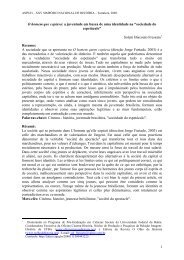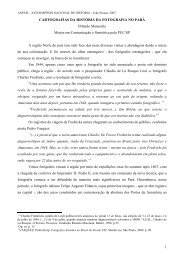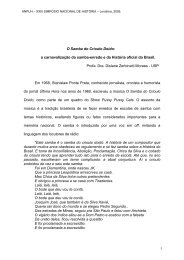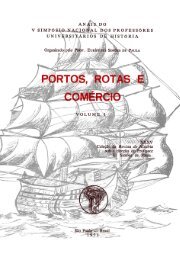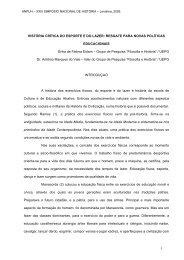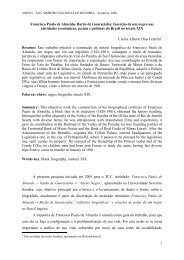anpuh.s02 - Associação Nacional de História
anpuh.s02 - Associação Nacional de História
anpuh.s02 - Associação Nacional de História
Create successful ePaper yourself
Turn your PDF publications into a flip-book with our unique Google optimized e-Paper software.
tam a necessida<strong>de</strong> do trabalho comum para o melhor aproveitamento<br />
da terra. Tal sistema era empregado nas extensas proprieda<strong>de</strong>s <strong>de</strong><br />
cultivo cujas origens remontam certamente, aos tempos pré-históricos.<br />
Era necessária a colaboração <strong>de</strong> todos os membros da comunida<strong>de</strong><br />
nas tarefas que resultariam em beneficio <strong>de</strong> todos. A ativida<strong>de</strong><br />
comum <strong>de</strong> arar, <strong>de</strong> plantar, e <strong>de</strong> colhêr, sob um mesmo comando, faz<br />
com que consi<strong>de</strong>remos êste tipo <strong>de</strong> proprieda<strong>de</strong> comunitária, o mais<br />
caracteristico e aquêle que mais profundamente correspon<strong>de</strong> a uma<br />
instituição <strong>de</strong> caráter social. Realizadas as colheitas, todos os animais,<br />
todo o gado daquelas populações, constituindo como que um<br />
rebanho comum, pasta naquelas terras, aproveita do solo as restevas<br />
e i<strong>de</strong>ntificando ainda mais, pelo interêsse <strong>de</strong> cada um e <strong>de</strong> todos,<br />
aquelas populações.<br />
Deve-se ainda acentuar que a ativida<strong>de</strong> <strong>de</strong> cada um <strong>de</strong>pen<strong>de</strong> da<br />
ativida<strong>de</strong> <strong>de</strong> todos e que a igualda<strong>de</strong> econômica dos proprietários <strong>de</strong>ve<br />
ter sido a regra geraL Em caso <strong>de</strong> enfermida<strong>de</strong> ou <strong>de</strong> invali<strong>de</strong>z,<br />
atuam os vizinhos resolvendo os problemas daqueles que a má sorte<br />
tenha prejUdicado. Verda<strong>de</strong>iras estruturas <strong>de</strong> caráter social marcam e<br />
caracterizam aquelas instituições, apresentando-as como prenúncio<br />
do que realizaram ou <strong>de</strong>veriam ter realizado os homens do século xx.<br />
COMMUNITY PROPERTY IN THE XII AND XIll CENTURIES<br />
SUMMARY<br />
The author divi<strong>de</strong>s his work into four chapters: 1) Introduction.<br />
2) Communal Property in the barbarian period. 3) Importance of<br />
the XII and XIII centuries. 4) Common Property or Social Property.<br />
In the first chapter the author points out the difficulty that the<br />
historian of Medieval Ages has concernlng early sources. He says<br />
that in the Middle Ages there was no differentiation between property<br />
of land and social problems, that they complemented each<br />
other, and that Church legislation and life were related to these<br />
problems in a higher <strong>de</strong>gree than the State law.<br />
Going on he analyses the different kinds of land property in the<br />
barbarian period, examining the Mark or Allmen<strong>de</strong>n, the property<br />
which belonged at once to the community and to its components.<br />
In the third chapter he says that he consi<strong>de</strong>rs the XII and XIll<br />
centuries the most important and <strong>de</strong>cisive in the historical transformation<br />
of the Middle Ages. He analyses the political events, the<br />
agrarian progress, the increase in population, the rising towns, the<br />
evolution of thought in consequence of philosophical studies, art and<br />
literature, and conclu<strong>de</strong>s that these centuries may be consi<strong>de</strong>red<br />
structurally as mo<strong>de</strong>m.<br />
In the last chapter he says that the most important forms of<br />
use of land in the XII and XIII centuries was community or social<br />
62






